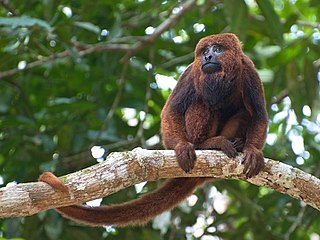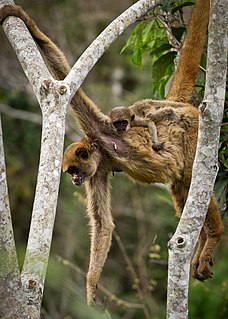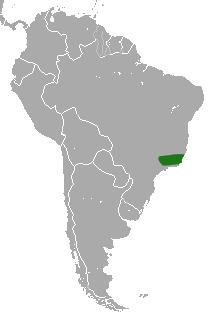 W
WThe Atlantic Forest climbing mouse is an arboreal rodent species in the family Cricetidae from South America. It is found in the Atlantic Forest of southeastern Brazil at elevations from sea level to 1500 m. Its karyotype is 2n = 44, FN = 74–80.
 W
WThe Brazilian big-eyed bat is a species of phyllostomid bat from South America. The scientific name honours Italian naturalist Giacomo Doria.
 W
WThe Brazilian funnel-eared bat is a South American bat species found in eastern Brazil and in Paraguay. It roosts in caves, which makes it vulnerable to disturbance of these scarce sites, and in particular, to extermination campaigns against cave-roosting bats carried out in Brazil to combat rabies.
 W
WThe black capuchin,, also known as the black-horned capuchin, is a capuchin monkey from the Atlantic Forest in south-eastern Brazil and far north-eastern Argentina. Historically, it was included as a subspecies of the tufted capuchin.
 W
WThe blond capuchin is a species of the capuchin monkeys group, the genus Sapajus. This endangered species was rediscovered in 2006. It is endemic to northeastern Brazil.
 W
WThe crested capuchin or robust tufted capuchin is a species of robust capuchin monkey. It is endemic to Brazil. It was formerly considered a subspecies of the black capuchin but is now considered by some to be a separate species.
 W
WThe brown howler, also known as brown howler monkey, is a species of howler monkey, a type of New World monkey that lives in forests in southeastern Brazil and far northeastern Argentina (Misiones). It lives in groups of two to 11 individuals. Despite the name "brown howler", it is notably variable in colour, with some individuals appearing largely reddish-orange or black.
 W
WThe northern brown howler is the type subspecies of the brown howler, native to Brazil. It is listed as critically endangered, with fewer than 250 individuals restricted to vicinity of the Jequitinhonha River. The species feeds on fruits, flowers, and by preference immature leaves which are easier to digest than mature leaves; foraging for these foods in hillside habitats was shown to require more energy expenditure than in valley habitats.
 W
WThe southern brown howler is a monkey subspecies of brown howler native to southeastern Brazil and far northeastern Argentina (Misiones). Gregorin, 2006, considered the southern brown howler to be a separate species, Alouatta clamitans, but this has not been universally accepted.
 W
WPeracchi's nectar bat is a species of nectar-feeding bat in the family Phyllostomidae. It was first described from the Atlantic Forest in southeastern Brazil.
 W
WThe buffy-tufted marmoset, also known as the buffy tufted-ear marmoset or white-eared marmoset, is a New World monkey that lives in the forests on the Atlantic coast of southeast Brazil. Of all the marmosets, it has the southernmost range.
 W
WThe northern muriqui is an endangered muriqui or woolly spider monkey species endemic to Brazil. It is unusual among primates in that it shows egaliterian social relationships. It is found in the Atlantic Forest region of the Brazilian states of Rio de Janeiro, Espírito Santo, Minas Gerais and Bahia. Muriquis are the largest species of New World monkeys. The northern muriqui can grow up to 4.3 ft long. It feeds mainly on leaves and twigs, but will also eat fruit. It often hangs upside-down by its prehensile tail while eating.
 W
WThe southern muriqui is a muriqui species endemic to Brazil. It is found in the Brazilian states of Paraná, São Paulo, Rio de Janeiro, Espírito Santo and Minas Gerais. This New World monkey is known locally as mono carvoeiro, which translates to "charcoal monkey".
 W
WThe northern three-striped opossum is an opossum species from South America.
 W
WThe Brazilian gracile opossum is a species of small opossum from Brazil.
 W
WThe Brazilian slender opossum is an opossum species from South America. It is found in moist montane forest in the Atlantic Forest region of southeastern Brazil, including the states of Minas Gerais, Rio de Janeiro, São Paulo and Paraná. Its breeding may be fully semelparous, which is unusual for a mammal.
 W
WThe southeastern four-eyed opossum is an opossum species native to South America. It is found in Atlantic Forest ecoregions, in Brazil, Paraguay and Argentina.
 W
WThe southern red-sided opossum is an opossum species from South America. It is found in Argentina, Brazil and Paraguay.
 W
WThe southern three-striped opossum is an opossum species from South America. It is found in the Atlantic Forest region of Brazil.
 W
WThe soft-spined Atlantic spiny-rat, Trinomys dimidiatus, is a spiny rat species from South America. It is endemic to Brazil.
 W
WThe Atlantic titi or masked titi is a species of titi, a type of New World monkey, endemic to Brazil.